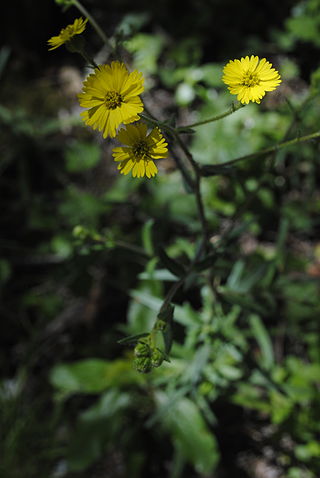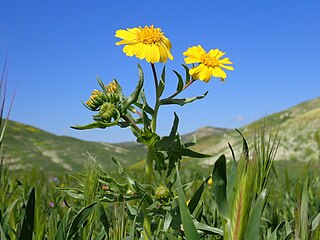
Madia is a genus of annual or perennial usually aromatic herbs with yellow flowers, in the tribe Madieae within the family Asteraceae.

Eatonella is a North American genus of plants in the family Asteraceae containing the single known species Eatonella nivea, which is called by the common name white false tickhead. This small annual is native to the western United States, particularly the Great Basin, where it grows in sandy soils. It has been found in Washington, Oregon, Idaho, Nevada, and eastern California.

Madieae is a tribe of flowering plants in the family Asteraceae. It is sometimes considered a subtribe of Heliantheae. Notable species include the tarweeds of the Western United States as well as the silverswords of Hawaii.
Madia anomala is a species of flowering plant in the family Asteraceae known by the common name plumpseeded madia. It is endemic to northern California, where it can be found on hillsides in the San Francisco Bay Area and adjacent mountains and valleys.
Kyhosia is a monotypic genus of flowering plants in the family Asteraceae containing the single species Kyhosia bolanderi, which is known by the common names Bolander's madia and kyhosia.
Harmonia doris-nilesiae is a species of flowering plant in the family Asteraceae known by the common names serpentine tarweed and Niles' madia.

Madia exigua is a species of flowering plant in the family Asteraceae known by the common names small tarweed and threadstem madia.

Madia gracilis is a species of flowering plant in the family Asteraceae known by the common names grassy tarweed, slender tarweed, and gumweed madia.
Harmonia hallii is a species of flowering plant in the family Asteraceae known by the common names Hall's harmonia and Hall's madia.

Anisocarpus madioides is a North American species of flowering plant in the family Asteraceae known by the common name woodland madia.
Harmonia nutans is a species of flowering plant in the family Asteraceae known by the common name nodding madia.

Madia radiata is a species of flowering plant in the family Asteraceae known by the common names golden madia and showy madia. It is endemic to California, where it is known mostly from the Central Coast Ranges and adjacent edges of the San Francisco Bay Area and Central Valley.
Jensia yosemitana is a species of flowering plant in the family Asteraceae known by the common name Yosemite tarweed. It is endemic to California, where it has a scattered distribution across the Sierra Nevada and its foothills. Some of the populations lie inside Yosemite National Park.
Carlquistia is a rare North American genus of flowering plants in the family Asteraceae containing the single species Carlquistia muirii. Formerly named Raillardiopsis muirii, the plant was reexamined in the 1990s and moved to a new genus of its own, separate from similar and closely related genera, such as Madia. Common names for the species include Muir's tarplant, Muir's raillardiopsis, and Muir's raillardella.

Arnica dealbata is a species of Californian plants in the tarweed tribe within the aster family

Deinandra conjugens is a rare species of flowering plant in the family Asteraceae known by the common names Otay tarplant and Otay tarweed. It is native to a small section of far northern Baja California in Mexico, its range extending north into San Diego County, California, in the United States. One isolated population has been reported from the hills east of Cayucos in San Luis Obispo County.

Jensia is a genus of flowering plants in the family Asteraceae, endemic to California.

Anisocarpus is a genus of flowering plants in the tribe Madieae within the family Asteraceae.

Hymenothrix dissecta is a North American species of flowering plants in the family Asteraceae known by the common names yellow ragweed and ragleaf bahia. It is native to the western United States as far north as the Black Hills of South Dakota and Wyoming, as well as in northern Mexico.

Centromadia parryi, the pappose tarweed, is a species of plant in the tribe Madieae within the family Asteraceae. It is found in North America where it is native to California and, northern Baja California.











